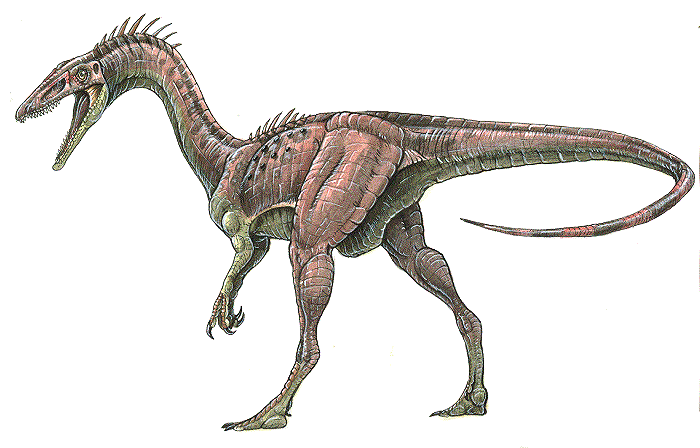|
|
 |
|
Coelophysis bauri
(Edward Cope 1889) |
|
 |
|
Name Means: |
"Hollow Form" |
Length: |
10 feet |
|
Pronounced: |
SEE-low-FIE-sis |
Weight: |
50 pounds |
|
When it lived: |
Late Triassic, 220 million years ago |
|
|
|
Where found: |
|
|
|
|
|
Introduction |
A small tyrannosaur? Yep. Carnivores come in all size.
This little fellow was only about ten feet long and three feet tall
and weighed only 50 pounds. It walked upright on its strong birdlike
hind legs. Its front limbs ended in three clawed fingers that
could grab and tear prey. Its jaws containing 100 small, sharp
teeth. It probably ate lizards, amphibians, and even other small
dinosaurs. Its lineage gave rise to the dinosaurs still living today
-- the birds.
Because of its small size, Coelophysis probably
traveled and hunted in herds. It was a small, agile predator and was
seen running very convincingly all over the TV screen in "Walking With
Dinosaurs." A Coelophysis skull from the Carnegie Museum of
Natural History was flown into space by the space shuttle Endeavor on
January 22, 1998. It traveled to the space station Mir. It was not the
first dinosaur in space.
Maisaura became an astronaut
almost three years earlier.
It one of the most well-known and extensively studied tyrannosaurs.
This is due to the wealth of fossil material. Several hundred
Coelophysis fossil skeletons have been found in Arizona, New Mexico,
and perhaps Utah. The quarry at Ghost Ranch, near
Albuquerque,
New Mexico has yielded dozen of specimens.
It lived during the Late Triassic Period, about 210
million years ago, at a time when northern New Mexico was an arid,
lowland environment. Periodic monsoonal rains interrupted the dry
conditions, producing flash floods that swept across the land. One of
these flash floods may have drowned an entire herd of Coelophysis,
causing the great concentration of bones that is found at Ghost Ranch.
Both adults and juveniles have been found. There are two
types of adults, "robust" and "gracile" - these two morphs may
represent males and females. Coelophysis have been found with
small Coelophysis bones inside of them. Some authorities
believe that they may have eaten their young; others think that they
may have been pregnant females. However, it is generally
believed that Coelophysis laid eggs.
|
|
Discocvery |
|
Coelophysis was discovered in 1881 by David Baldwin. It was named by
US paleontologist Edward Drinker Cope in 1889. The type species is
Coelophysis bauri (named by Cope and Colbert in 1964). There is
some confusion about the naming of this genus arising from the
fragmentary nature of the type specimen. At one time these
dinosaurs were called Rioarribasaurus, but this name was later
dropped. After a campaign by the New Mexico Museum of Natural
History, Coelophysis became New Mexico's state fossil on March
17, 1981. |
| |
|
|
|
|
|
|
|
|
Edugraphics.Net | Feenixx Publishing |
|
|
|
|
|

